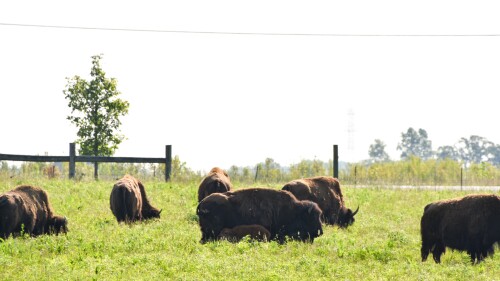Columbus may be a major city, but that doesn’t mean we aren’t connected to Mother Nature. From our various metro parks to local green spaces, her presence can be felt in all corners of the city.
But, have you ever wondered what makes up Columbus’ nature? We did, so we decided to dig in + share our field notes on how to create a Columbus-themed mini terrarium at home.
Note: With all things in nature, the best practice is to leave no trace. Follow general rules and guidelines in parks, and only search for items that are abundant.
Choose your jar
We recommend upcycling an old jar for your terrarium home, and bonus points if it has a lid. Anything from a cleaned pasta sauce jar to a fish bowl will work, but we suggest something you can fit your hand into for easier placement. Pro tip: City Editor Mitch found his at Goodwill for $1.
Adding filtration
No need to be fancy here — just plain old rocks. And if you didn’t know, most of the rocks found in the state are clay, shale, limestone, sandstone, or coal.
You might be asking: why rocks? These will let access water pool at the bottom so your plants and soil don’t drown in the future.

Use dead tree limbs to decorate your terrarium — just be cautious of mold. | Photo by CBUStoday
Adding substrate
Substrate is a fancy term for soil + you can find this in any park in the city. Most of Ohio’s soil is considered sand, silt, or clay — each with their own ways of handling water. Keep this in mind when deciding your substrate.
You can also build your own substrate with various products from hardware + gardening stores, such as Strader’s Garden Center.
Choose your plants
Think of this jar set up like a super powered greenhouse. This means certain temperate plants — such as flowers — just won’t survive in the intense humidity without lots of love and care.
Instead, look for plants that don’t require much effort, like moss and lichen. Take a look at the Ohio Moss and Lichen Association for in-depth details on the fuzzy plant.
Maintaining your terrarium
One of the most common killers of household plants is actually over watering — not under watering.
This means your terrarium may not need to be watered more than once a month — if that. Keep an eye on it and if the soil looks a bit dry, give it some water. If you went a little overboard, no worries — the rocks are in place + the humidity will help evaporate it over time.
When watering, it’s recommended to use distilled water as it is free of various treatments found in tap water.
Final thoughts
- Some experts recommend springtails to help fight off the growth of mold.
- If your jar doesn’t have a lid, you can create one using plastic wrap and a rubber band — easy and affordable.
- Indirect sunlight, or a controlled lamp, can help prolong the life of your terrarium.










